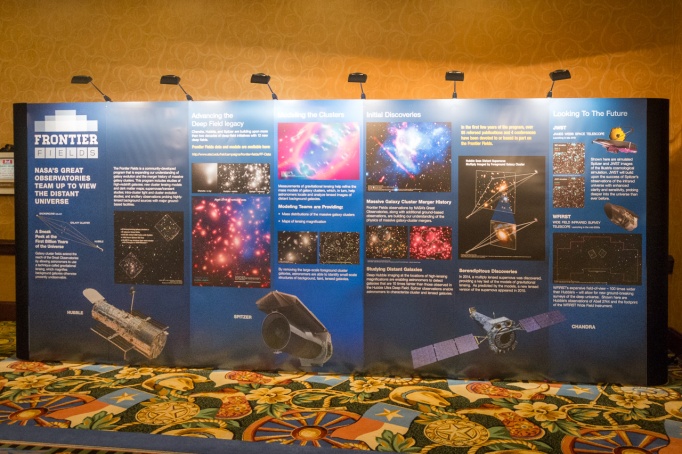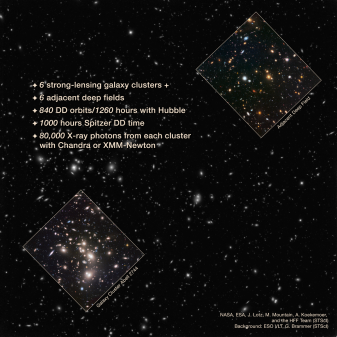NASA’s Frontier Fields program has reached a critical point. The observations by NASA’s Great Observatories (Hubble, Spitzer, and Chandra) are nearing completion, and the full data are nearly all online for astronomers (or anybody else for that matter) to study. To herald this part of the program, the Frontier Fields were highlighted at the January American Astronomical Society (AAS) meeting in Grapevine, Texas, where over 2,500 astronomers gathered to discuss the cosmos. A new exhibit was displayed to help tell the story of the Frontier Fields program to the science community. We share that story with you below.

Shown here is the NASA Frontier Fields exhibit at the 229th AAS meeting, in Grapevine, Texas. Credit: Z. Levay (STScI)
NASA’s Great Observatories Team Up to View the Distant Universe
The Frontier Fields is a program developed collaboratively by the astronomical community. Despite the fact that observations are coming to an end, the wealth of data being added to NASA archives will ensure new discoveries for years to come.
The NASA Frontier Fields observations are providing the data for astronomers to
- expand our understanding of how galaxies change with time
- discover and study very distant galaxies
- refining our mathematical models of gravitational lensing by galaxy clusters
- explore the dark matter around galaxy clusters
- analyze the light from supernovae
- study the diffuse light emitted from gas within galaxy clusters
- study how galaxy clusters change with time

Advancing the Deep Field Legacy
Chandra, Hubble, and Spitzer are building upon more than two decades of deep-field initiatives with 12 new deep fields (six galaxy cluster deep fields and six deep fields adjacent to the galaxy cluster fields).
By using Hubble, Spitzer, and Chandra to study these deep fields in different wavelengths of light, astronomers can learn a great deal about the physics of galaxy clusters, galaxy evolution, and other phenomena related to deep-field studies. Observations with Hubble provide detailed information on galaxy structure and can detect some of the faintest, most distant galaxies ever observed via gravitational lensing. Spitzer observations help astronomers characterize the galaxies in the image, providing details on star formation and mass, for example. High-energy Chandra X-ray images probe the histories of the giant galaxy clusters by locating regions of gas heated by the collisions of smaller galaxy sub-clusters.
An example of images taken by Hubble, Spitzer, and Chandra of the Frontier Fields galaxy cluster Abell 2744 are shown below. These images show how astronomers can use color to highlight the type of light observed by each of NASA’s Great Observatories.
Developing Mathematical Models of the Clusters
By discovering background galaxies that are obviously multiply lensed, and measuring their distances, astronomers can use Einstein’s theory of general relativity to map out the distribution of mass (normal matter plus dark matter) for the galaxy cluster.
Once this mass distribution is known, astronomers can go back and look at regions where they expect the largest magnification of distant galaxies, again due to Einstein’s theory of general relativity. From these calculations, astronomers can develop magnification maps that highlight the regions where Hubble is most likely able to observe the most distant galaxies. This technique has allowed astronomers to detect ever-more distant galaxies in these fields and has helped astronomers better refine their models of mass distributions.


Initial Discoveries
In the first few years of the program, over 85 refereed publications and 4 conferences have been devoted to or based, in part, on the Frontier Fields, including a workshop at Yale in 2014 and a meeting in Hawaii in 2015. Three types of science results are highlighted below.


Studying the Histories of Merging Galaxy Clusters
Frontier Fields observations by NASA’s Great Observatories, along with additional ground-based observations, are building our understanding of the physics of massive galaxy-cluster mergers.
Studying Distant Galaxies
By studying Hubble Space Telescope deep imaging at the locations where gravitational lensing magnifications are predicted to be high, astronomers are detecting galaxies that are up to 100 times fainter* than those observed in the famous Hubble Ultra Deep Field. Infrared observations by the Spitzer Space Telescope enable astronomers to better understand the masses, and other characteristics, of background lensed galaxies and those residing within a massive galaxy cluster.
*Author note: this has been updated from 10 times fainter than the Hubble Ultra Deep Field to 100 times fainter than the Hubble Ultra Deep Field due to recent published results you can find, here.
Serendipitous Discoveries
In 2014, a multiply lensed supernova was discovered, providing a key test of the models of gravitational lensing. As predicted by the models, a new lensed version of the supernova appeared in 2015. Learn more about the appearance of a new lensed version of Refsdal here.
Looking to the Future
Both the James Webb Space Telescope (JWST, scheduled to launch in late 2018) and the Wide Field Infrared Survey Telescope (WFIRST, scheduled to launch in the mid-2020s) will greatly expand our understanding of galaxies and the distant universe.
JWST will build upon the success of Spitzer’s observations of the infrared universe with enhanced clarity and sensitivity, probing deeper into the universe than ever before. Due to the expansion of the universe, light from the most distant galaxies are shifted to redder wavelengths, moving beyond the visible spectrum and into infrared light. One of JWST’s primary science goals is to observe these infant galaxies at the edge of the observable universe.
Imagine having a Hubble-class telescope that can observe in the infrared and see greater than an order of magnitude more of the sky with each observation. WFIRST’s expansive field-of-view – 100 times wider than Hubble’s – will allow for new ground-breaking surveys of the deep universe.
















